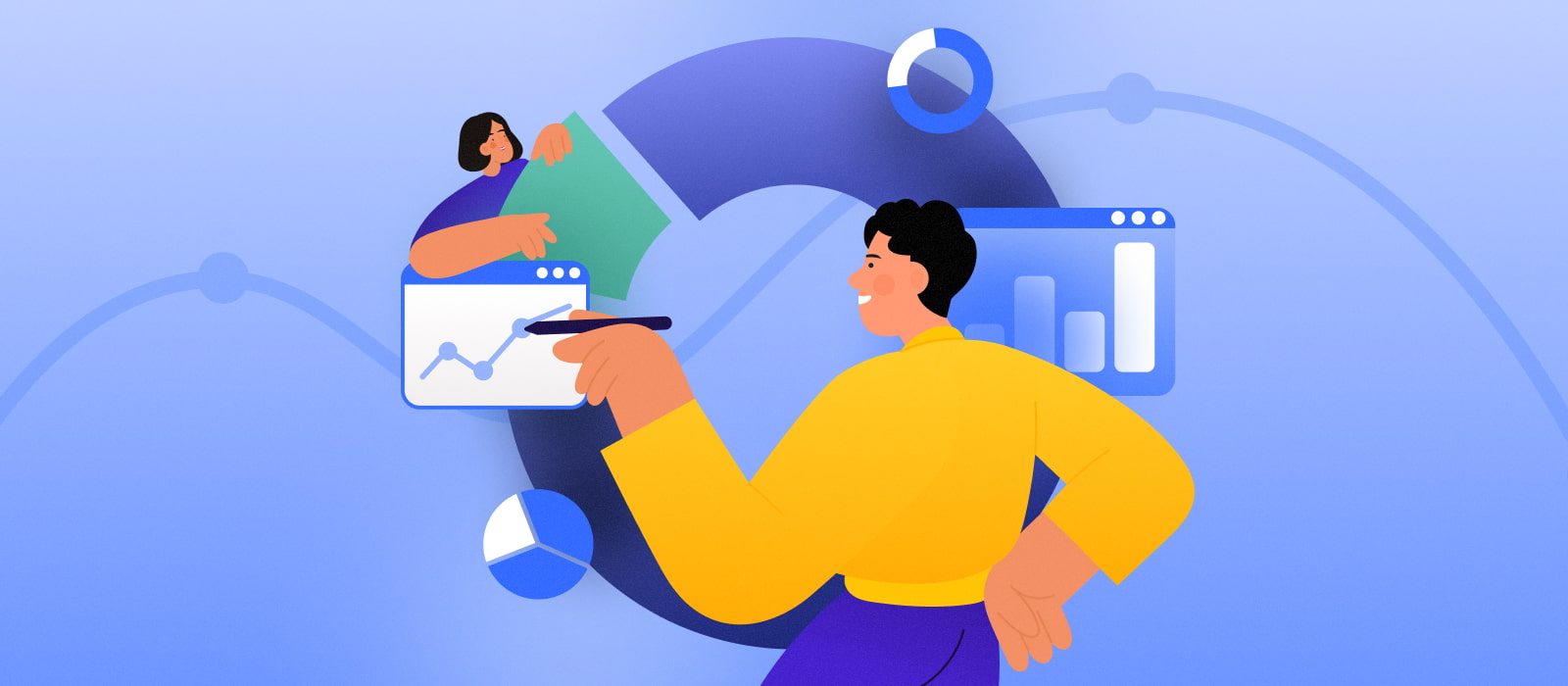Each of us produces massive amounts of data every day. And the most tech-savvy companies are already using this data to improve their decision-making. Now, the question is how to do it most efficiently.
Yep, data is everywhere. And the more digital we become the more data we create. According to Forbes, the amount of data produced in the world increased from 1.2 trillion gigabytes in 2010 to 59 trillion gigabytes in 2020, growth of almost 5,000%.
The increasing amount of data produced and consumed worldwide is leading to the development of solutions that are capable of collecting, manipulating, and analyzing it. That’s how we come to such fields as big data, data science, and data analytics.
Read on for explanations of what big data, data analytics, and data science are, to learn their differences, and to find out how each of them deals with data.
Why is data important?
Data is one of literally any company’s biggest assets. When used effectively, it can help a business make informed decisions, improve customer relationships, and increase revenue. According to global statistics, poor data quality costs companies worldwide up to $14.2 million each year. And at the macro level, for those operating in a data-driven economy like the US, this figure can reach trillions.
To establish a strong business presence, companies not only need to learn how to manage large sums of data but also find out how to use this data to its full potential. In a recent survey, Forbes found out that 95% of businesses need to manage unstructured data, 40% of them on a frequent basis. It is estimated that by 2025, more than 150 trillion gigabytes of data will need to be analyzed.
Ultimately this leads to a global demand for data analytics, big data, and data science services, all of which are aimed at helping businesses manage their data and receive actionable insights.
What is data science?
Data science is a broad concept, which presupposes gathering data from multiple sources and extracting critical information with the help of machine learning (ML), artificial intelligence (AI), predictive analytics, and sentiment analysis. Basically, its major goal is to provide businesses with accurate predictions and insights, thus enabling companies to confidently make critical business decisions.
![]()
The data science process generally includes these steps:
- Formulating research questions
- Collecting data from multiple disparate sources
- Preprocessing and cleansing raw data to make it ready for analysis
- Designing AI and ML models to mine big data sets
- Developing tools to track and analyze data accuracy
- Building data visualization tools such as dashboards, charts, and reports
- Implementing programs to automate data collection and processing
One of the most obvious examples of a data science application is the Google search engine, which applies data science algorithms to deliver the best results to search queries in just seconds.
However, there are many more applications for data science, including making healthcare predictions, analyzing customer behavior, receiving financial recommendations, or optimizing supply chains.
For example, United Parcel Service, a multinational shipping and supply chain management company, has an integrated navigation system called ORION. The solution applies data science algorithms, artificial intelligence and machine learning to help drivers choose over 66,000 fuel-efficient routes. The result speaks for itself — the company saved approximately 100M miles and 10M gallons of fuel per year.
Planning to integrate AI into your business workflows? We’re here to help
Data science is generally compared to machine learning, which also involves data extraction and analysis. Let’s figure out what their differences are through a data science vs machine learning comparison.
What are the differences between data science and machine learning?
The main distinction between data science and machine learning is that machine learning is one of the techniques of data science. Machine learning uses algorithms to extract data, learn from it, and make predictions. Data science, in contrast, is a much wider concept as it encompasses data engineering, data analytics, machine learning, predictive analytics, and more.
![]()
Data analysts have created a whole set of ML models for different use cases. Let’s check out some of the most popular:
- Linear regression/classification. Helps identify patterns in numeric data, including financial spreadsheets and reports
- Graphic models. Enable fraud detection and sentiment analysis
- Decision trees. Split the data into columns according to certain parameters (e.g. whether or not it is a good idea to invest in a new firm) and predict outcomes
- Deep learning neural networks. Used mainly in computer vision and natural language processing (Amazon’s Alexa, Apple’s Siri)
A great example of ML use is Instagram. The platform applies ML algorithms to identify user patterns and recommend interesting posts on users’ news feeds. Similarly, Netflix leverages ML and AI algorithms to advise users on movies and shows based on their watching history. According to Aish Fenton, software engineer at Netflix,
“80% of what people played on Netflix came from the recommendation algorithm.”
If you need help determining whether ML models or data science solutions are the right fit for your business case, you can reach out to our machine learning consulting services for expert guidance.
Meet CheckNFT.iO – an intelligent solution that uses data science and ML algorithms to identify fraud and analyze the value of non-fungible tokens
What is data analytics?
Data analytics involves analyzing large amounts of data with the help of specialized software and algorithms to answer questions and draw conclusions.
Many businesses collect huge amounts of data all the time. Yet, in its raw form, this data doesn’t mean anything. And this is where data analytics come into play, helping analyze raw data and get actionable insights.
The data analytics process generally includes:
- Identifying informational needs
- Acquiring data from primary and secondary sources
- Cleansing data for analysis
- Analyzing data to spot patterns and translate them into insights
- Presenting findings
There are also four main types of data analytics. These are:
- Descriptive analytics: aims to understand, evaluate, and describe something that has already happened.
- Diagnostic analytics: seeks to understand the “why” behind what has happened.
- Predictive analytics: relies on historical data and past trends to answer the question about what should happen in the future.
- Prescriptive analytics: tries to identify specific actions that a business should make to achieve its goals.
Both data science and analytics work with large sets of data and aim to help businesses make informed decisions, which is why they can easily be confused.
What is the difference between data analytics and data science?
The key difference between data analytics and data science is that data analytics mainly works with structured historical data to extract relevant patterns and conclusions, while data science mostly works with unstructured data and deals with trends and predictions.
So while data analytics helps convert a large number of figures in the form of data and present it in a simple format, data science is a broader term. It includes data analytics and uses more advanced techniques like machine learning models or predictive algorithms to explore new issues and solve analytically complex business problems.
What is big data?
Big data is a field that analyzes significant volumes of data that cannot be processed with traditional software. These volumes include unstructured (social networks, blogs, video files), semi-structured (text files, system log files), and structured data (databases, transaction data).
Big data leverages specialized hardware, software, processing techniques, and database technologies. According to Gartner,
“Big data is high-volume, high-velocity and/or high-variety information assets that demand cost-effective, innovative forms of information processing that enable enhanced insight, decision making, and process automation.”
As you might guess, big data and data science are other groups of terms that are commonly compared.
So, is data science the same as big data? Long story short, they are not the same terms. Big data may be considered a pool of data that has no value until it is analyzed. It is used for processing significant amounts of data. However, to utilize this data to extract valuable information a company would need data science.
To understand the differences between big data and data science, let’s take a look at the steps involved in processing big data. These include:
- Architecting distributed systems for collecting data and ensuring their scalability and security
- Building a large-scale data processing system to store and process huge amounts of data
- Processing the data using big data tools (Hadoop, Cassandra, Stats iQ)
Data science vs data analytics vs big data: what are their differences?
Now that we’ve got a basic understanding of data science, data analytics, and big data, let’s try to compare the three and identify their key differences. In the most basic words:
- Big data is a field that includes collecting and processing huge amounts of unstructured, semi-structured, and structured data
- Data science is a broad term that encompasses data analytics, ML, AI, and other algorithms to process structured and unstructured data, extract meaningful insights and predict future trends
- Data analytics works mostly with structured historical data to identify patterns and translate them into insights
Now, let’s proceed with a more detailed comparison of the three fields, paying attention to their characteristics, how they work with data, their goals, and their business applications.
And if you’re among those users who are not keen on long reads, you may simply scan the data science vs big data vs data analytics infographic below. Enjoy!
![]()
In addition, we prepared an informative video where our business analyst discusses data science, data analytics, business intelligence consulting, and big data along with the key differences between them. Check it out.
Key characteristics
Data analytics requires knowledge of mathematics and statistics along with skills such as data mining, data modeling, data analysis, database management, and reporting. As for programming skills, they usually include SQL, Python, SAS, Matlab, Excel, and Apache Spark.
When it comes to big data, mathematical and statistical skills are required, along with strong knowledge of programming languages and tools including Python, Java, R., Scala, Apache Spark, Apache Hadoop, Zoho Analytics, Samza, and RapidMiner. To effectively leverage big data, you’ll need to develop and manage large-scale databases.
Data science requires high mathematical, statistical, analytical, and programming skills for the development of ML models, data mining tools, and unstructured data techniques. Some of the most widely used technologies include Python, Scala, Julia, R., Pear, SAS, Java, Tableau, and Data Ladder. Knowledge of Hadoop platforms and database systems is also required.
Manipulating with data
Data scientists formulate questions, identify the best ways to get the answers and make predictions and future insights. They also provide techniques and tools to process big data by extracting information from it. To improve their predictions data scientists leverage machine learning algorithms.
Data analysts, in turn, receive questions and perform data analysis to find answers to these questions. They use historical data to spot inefficiencies and find trends.
Big data specialists collect large amounts of market data and process, visualize, and communicate it to help guide future decisions. Big data involves working with all types and formats of data from multiple sources.
Goals
Data analytics aims at extracting the relevant information from a dataset which is usually small and structured.
The goal of data science is to conduct different operations over multiple data sources to prove or disprove a certain hypothesis, ultimately providing actionable insights about the future.
Meanwhile, the goal of big data is to help organizations harness large data sets, extract meaningful insights, identify new opportunities, and develop business agility.
Business applications
There are multiple use cases for data science, big data, and data analytics relevant to any company that manipulates and manages data. We will focus on some of the most popular applications.
When it comes to data science, it proves to be efficient in such areas as:
- Search engines and recommendation systems. By making use of ML and AI algorithms they can deliver the best results for search queries.
- Diagnosing. With the help of data science, healthcare organizations can ensure accurate diagnosis and deliver personalized recommendations.
- Finance management and fraud detection. Data science allows corporations and financial organizations to optimize their financial workflows while detecting possible risks and fraud.
- Route optimizations. Data scientists can set up algorithms that will optimize shipping routes in real time, highly useful to logistics and transportation companies.
Customer data analysis. Data science can be used to evaluate customer behavior and deliver recommendations to attract new customers while improving customer loyalty.
Check out AIRA – a retina analysis and disease diagnosis solution that leverages AI and ML algorithms
Data analytics will be of great use in:
- Buying experience optimization. ECommerce organizations can apply data analytics techniques to gain insights into customer preferences based on their history of purchases. Similarly, travel organizations can increase browse-to-buy conversions via customized offers.
- In-game purchases. With the help of data analytics, game publishers can learn more about user likes and dislikes in order to optimize spend within and across games.
- Energy management. Many businesses use data analytics for monitoring network devices, energy optimization, and energy distribution.
And finally, we come to big data. Its most prominent business applications include:
- Financial services. Big data helps financial institutions, credit card companies, insurance firms, and venture funds to manage massive amounts of multi-structure data and improve compliance, optimize workflows, and prevent fraud.
- Communications. Using big data techniques and tools, businesses can attract new users, retain existing customers, and expand within their current subscriber bases.
- Retail. With big data solutions, retail organizations are able to analyze disparate data sources, such as customer transaction data, weblogs, loyalty program data, and social media history to optimize customer spend and stay competitive.
Real-life example: Netflix
To have a clearer picture of how data analytics, big data and data science can be applied in practice, let’s quickly take a look at a service we’re all very familiar with — Netflix.
Netflix generates a significant amount of user data each day, so it won’t be possible to analyze it with traditional software (at least, not quickly). So there’s a need for big data specialists who can evaluate massive amounts of unstructured data by creating a specific environment using various big data tools and technologies.
Then data scientists come into play. They evaluate how users interact with Netflix and analyze the impact of the quality of information (e.g., picture quality) on user behavior. Using ML models, they identify the types of content a user is likely to watch. With this data at hand, data scientists can help Netflix create personalized streaming experiences, optimize content caching, and improve the entire service.
Data analysts can assist data science in evaluating user behavior. For example, we have 50 different users, each of them with their own specific video preferences. Data analysts can create a personalized profile for each of these users. Data analysts can also create trending video lists as well as sorting a user’s recently watched videos and estimating whether they will continue to watch or stop watching a specific movie or show.
When to choose which one?
Whether we are talking about big data, data science, or data analytics, each of these tools is aimed at dealing with data to provide a business with useful insights and recommendations. In fact, quite often they are interconnected.
For example, big data is characterized by its volume, variety, and velocity while data science provides tools and techniques to analyze these large sets of data. It is often used for digging into insights provided by big data.
Data analytics will be useful for companies that have specific questions and want to find answers based on historical data. And data science will be helpful for organizations that want to optimize existing workflows, predict trends and receive unique insights about the future.
Closing thoughts
In this digital era, the amount of data, both structured and unstructured, is increasing each day. If companies want to stay competitive in the market, it is crucial for them to manage their data effectively.
Big data, data science, and analytics have proved to be efficient tools which help companies identify inefficiencies, personalize their service delivery, optimize workflows, and minimize risk.
If you want to use your business data to its full potential and get actionable insights, you are welcome to visit our big data consulting page and send us your query using the contact form.
Our seasoned developers and consultants will deliver research and development services to help you select and integrate the solution that fits your specific business needs.




